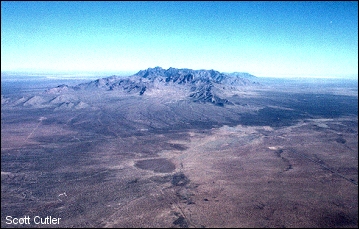

One of the secrets to the great biodiversity of the Chihuahuan Desert lies in its mountain islands. Plants and animals moved south during the Pleistocene ice age, when northern climates extended far into the Southwest. As things warmed up and dried out at the end of the Pleistocene, the only remaining habitats in the south for creatures of the north were in the cool, moist highlands. But like inhabitants of islands when the sea level rises, these northerners may be doomed. The global average temperature has climbed by over a degree in the last 100 years and, in the face of greenhouse warming, is projected to rise between about 2.5 and 8.7 degrees in the next 100.
Although these increasing temperatures may not sound like a big deal to
you, you aren't being driven to higher and higher mountain elevations by increasing
heat and aridity. There's one huge drawback to relying on montane climates—as
you're pushed upwards, sooner or later you run out of mountain. As on islands in a
rising sea, there's no place left to go!

Listen to the Audio (mp3 format) as recorded by KTEP, Public Radio for the Southwest.
Contributor: Arthur H. Harris, Laboratory for Environmental Biology, Centennial Museum, University of Texas at El Paso.
Desert Diary is a joint production of the Centennial Museum and KTEP National Public Radio at the University of Texas at El Paso.

The Organ Mountains from the south. The island nature of this montane range is evident in the aerial view. Surrounded by Chihuahuan Desert vegetation, the range supports forest and woodland in the higher elevations. Photograph by S. M. Cutler.